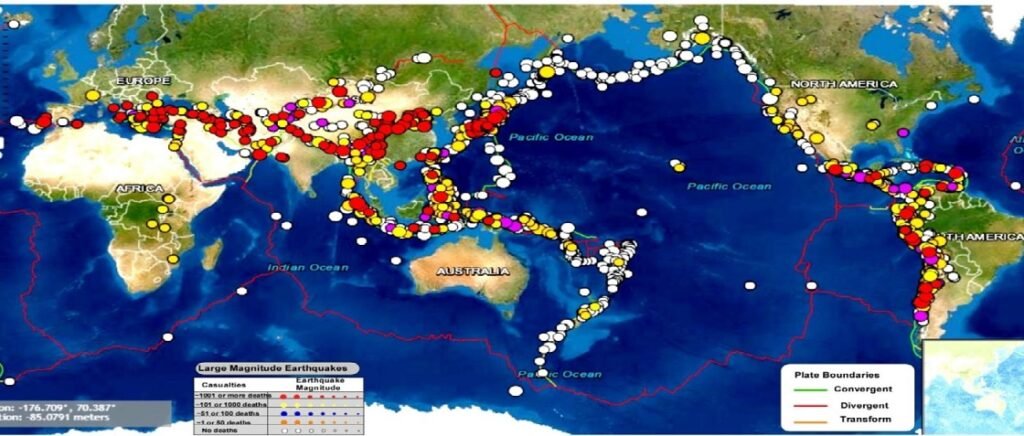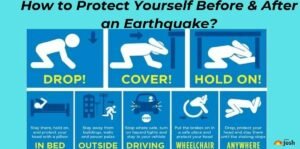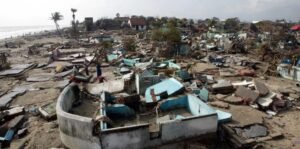
Earthquakes are among the most powerful and devastating natural disasters on Earth. They occur when there is a sudden release of energy in the Earth’s crust, causing seismic waves that shake the ground. These events can result in significant destruction, loss of lives, and economic setbacks. Understanding quakes, their causes, effects, and preparedness measures is crucial for mitigating their impact. This article delves deep into various aspects of quakes, including their causes, types, measurement, historical instances, and safety measures.”
What Causes an Earthquake?
The primary cause of earthquakes is the shifting of tectonic plates beneath the Earth’s surface. The Earth’s crust is divided into large, rigid plates that float on the semi-fluid mantle. These tectonic plates are in continuous motion, though their movement is extremely gradual. When two plates interact, they generate stress that builds up over time. When the stress surpasses a certain threshold, it is released in the form of an earthquake.
Types of Plate Boundaries Leading to Earthquakes
- Convergent Boundaries – When two tectonic plates collide, one plate is forced beneath the other, creating intense seismic activity.
- Divergent Boundaries – When plates move apart from each other, magma rises to fill the gap, causing minor earthquakes.
- Transform Boundaries – Plates slide past each other horizontally, leading to powerful and often destructive earthquakes.
- Additionally, human activities such as mining, fracking, and reservoir-induced seismicity (from large dams) can also trigger earthquakes.
Types of Earthquakes
Earthquakes can be classified based on their causes and depth of origin:
- Tectonic Earthquakes – These are the most common and occur due to tectonic plate movements.
- Volcanic Earthquakes – Triggered by volcanic activity, these earthquakes occur when magma movement causes pressure changes beneath the surface.
- Collapse Earthquakes – Resulting from the collapse of underground mines or caverns, these are generally localized and minor.
- Explosion Earthquakes – Induced by nuclear tests or large explosions, they are human-made and limited in impact compared to natural earthquakes.
- Deep-Focus Earthquakes – Occurring at depths greater than 300 km, these earthquakes tend to be less destructive.
- Shallow-Focus Earthquakes – These occur at depths less than 70 km and are often more destructive due to their proximity to the surface.
Measuring Earthquakes
The intensity and magnitude of an earthquake are measured using:
- The Richter Scale quantifies an earthquake’s magnitude by analyzing the amplitude of seismic waves.
- Moment Magnitude Scale (Mw) – Used by modern seismologists to provide accurate readings.
- Mercalli Intensity Scale – Measures the earthquake’s impact based on human perception and structural damage.
Seismologists use seismographs to detect ground vibrations and predict aftershocks. With advancements in artificial intelligence, AI-driven algorithms are now being used to analyze seismic data in real time.
Devastating Earthquakes in History
Several earthquakes have had catastrophic effects on human civilization. Some of the deadliest include:
- 1906 San Francisco Earthquake (USA) – A 7.9 magnitude earthquake caused massive destruction and fires in the city.
- 2004 Indian Ocean Earthquake and Tsunami – With a magnitude of 9.1–9.3, this quake triggered a deadly tsunami, killing over 230,000 people.
- 2010 Haiti Earthquake – A 7.0 magnitude earthquake led to widespread devastation and loss of over 200,000 lives.
- 2011 Tōhoku Earthquake (Japan) – A 9.0 magnitude earthquake caused a tsunami and led to the Fukushima nuclear disaster.
- 1976 Tangshan Earthquake (China) – One of the deadliest earthquakes, resulting in the deaths of nearly 242,000 people.
Effects of Earthquakes
Earthquakes can have widespread effects, including:
- Ground Shaking – The primary effect that can lead to building collapse and infrastructure damage.
- Landslides – Triggered in mountainous regions, leading to further destruction.
- Tsunamis – Underwater earthquakes can generate massive ocean waves, devastating coastal areas.
- Soil Liquefaction – The shaking causes saturated soil to behave like liquid, leading to structural failures.
- Fires and Gas Leaks – Damaged pipelines and electrical lines can ignite fires after an earthquake.
Earthquake Preparedness and Safety Measures

Before an Earthquake
- Identify safe spots in buildings (under sturdy furniture, away from windows).
- Secure heavy furniture and appliances to walls.
- Keep emergency kits with food, water, flashlights, and first-aid supplies.
- Conduct regular earthquake drills.
During an Earthquake
- Drop, Cover, and Hold On under a sturdy object.
- Stay indoors and move away from windows and fragile structures.
- If you are outdoors, distance yourself from structures, trees, and electrical wires to ensure safety.
After an Earthquake
- Check for injuries and provide first aid.
- Be cautious of aftershocks.
- Inspect buildings for structural damage before re-entering.
- Avoid using elevators and check for gas leaks.
Scientific Advancements in Earthquake Detection
Advancements in technology have significantly improved earthquake detection and response systems:
- Seismographs – Advanced instruments that measure and record seismic waves.
- Early Warning Systems – AI-driven algorithms help detect tremors and provide alerts.
- Satellite Monitoring – Used for detecting tectonic movements and earthquake-prone zones.
- Smart Infrastructure – Buildings designed to withstand seismic activity reduce damage and casualties.
The Role of Fault Lines in Earthquake Activity
Fault lines are fractures in the Earth’s crust where tectonic plates meet and interact. These boundaries experience immense pressure, leading to sudden shifts that cause earthquakes. The movement along fault lines can be slow and gradual or abrupt and violent. Understanding these zones helps predict and mitigate earthquake risks.
How Climate Change May Influence Seismic Activity
Scientists are increasingly exploring the potential links between climate change and seismic activity, as environmental shifts may subtly influence Earth’s tectonic processes. The rapid melting of glaciers and ice sheets is redistributing massive weight across continents, potentially altering stresses on fault lines and increasing earthquake risks in certain regions.
Rising sea levels may exert additional pressure on coastal faults, while changes in groundwater patterns from extreme rainfall or droughts could affect fault stability. Some studies suggest that the sudden loss of ice mass might even trigger “ice-quakes” or reactivate dormant faults in polar and mountainous areas. While the relationship remains complex and not fully understood, these emerging connections highlight how human-driven climate change could have unexpected geological consequences beyond rising temperatures and extreme weather.
Historical Earthquakes That Changed the World
The 1755 Lisbon earthquake triggered tsunamis and fires that reshaped Europe’s philosophical and scientific outlook. San Francisco’s 1906 earthquake revealed the dangers of unregulated urban development along fault lines. The 1960 Chile earthquake, the strongest ever recorded at 9.5 magnitude, revolutionized our understanding of plate tectonics. Japan’s 2011 Tohoku earthquake caused a devastating tsunami that led to global nuclear safety reforms. The 2004 Indian Ocean earthquake created humanitarian crises that transformed international disaster response systems.
Innovations in Earthquake-Resistant Architecture
Base isolation systems allow buildings to move independently from ground motion, significantly reducing structural damage during quakes. Engineers now use shape memory alloys in construction materials that can return to their original form after bending during seismic activity. Tuned mass dampers, massive counterweights in skyscrapers, counteract building sway caused by earthquakes through precise movements. New seismic retrofitting techniques strengthen older structures by adding steel frames or carbon fiber wraps without altering their appearance. Researchers are developing self-healing concrete with bacteria that automatically repairs earthquake-induced cracks when exposed to water.
The Future of Earthquake Prediction: Can We Forecast the Next Big One?

Scientists are developing AI systems that analyze seismic patterns to identify potential precursors to major quakes. Advances in satellite technology now allow detection of subtle ground deformations that may signal accumulating tectonic stress. Researchers are testing electromagnetic field monitoring as a possible indicator of impending seismic activity. Undersea sensor networks and dense urban seismic arrays provide real-time data for improved forecasting models. While precise prediction remains elusive, these technologies may soon enable reliable short-term earthquake warnings.
Conclusion
Earthquakes remain an unpredictable force of nature, but understanding their causes, effects, and safety measures can help minimize damage and loss of life. Scientific advancements in detection and preparedness have made a significant impact, yet individual and community readiness remains vital. By staying informed and prepared, we can mitigate the risks associated with these natural disasters.
FAQs
- What is the biggest earthquake ever recorded?
- The largest recorded earthquake was the 1960 Valdivia earthquake in Chile, measuring 9.5 on the Richter scale.
- Can animals predict earthquakes?
- Some animals exhibit unusual behavior before earthquakes, but there is no scientific consensus on whether they can predict seismic events.
- How do scientists predict earthquakes?
- Scientists use seismographs, satellite data, and tectonic activity patterns to analyze earthquake-prone areas, but exact predictions remain challenging.
- What should I do during an earthquake if I’m in a car?
- Pull over to a safe location away from bridges and buildings and remain inside the vehicle until the shaking stops.
- What are the safest countries for earthquakes?
- Countries with strong building codes and early warning systems, such as Japan and the USA, are considered safer in terms of earthquake resilience.
- Can earthquake-proof buildings really prevent damage?
- While they cannot prevent earthquakes, earthquake-resistant structures significantly reduce casualties and damage by absorbing seismic shocks.
- Why do some earthquakes trigger tsunamis?
- If an earthquake occurs underwater and shifts the ocean floor, it can generate massive waves that lead to tsunamis.







